D Link WA126A1 High Power Wireless N 150 USB Adapter User Manual Manual Part 1
D Link Corporation High Power Wireless N 150 USB Adapter Manual Part 1
D Link >
Contents
- 1. Manual Part 1
- 2. Manual Part 2
- 3. Manual Part 3
- 4. Manual Part 4
Manual Part 1
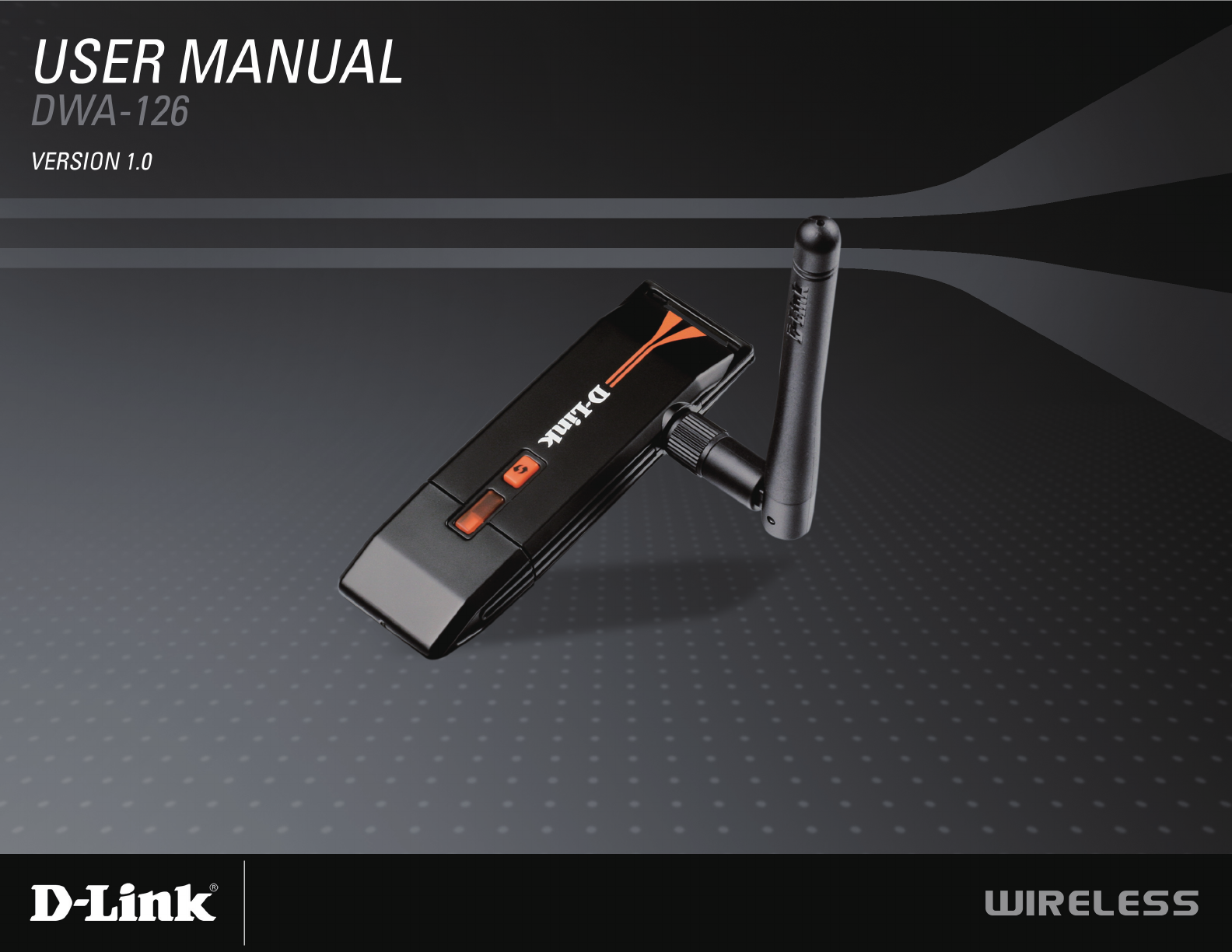

2D-Link DWA-126 User Manual
Table of Contents
Product Overview ........................................................ 3
Package Contents ...................................................3
System Requirements ............................................. 3
Introduction ..............................................................4
Features .................................................................. 5
Hardware Overview ................................................. 6
Installation ....................................................................7
Getting Started ........................................................7
Remove Existing Installations ............................ 7
Disable Other Wireless Adapters ....................... 8
Wireless Installation Considerations ...................... 10
Adapter Installation ................................................11
Conguration ............................................................. 17
D-Link Wireless Connection Manager ................... 17
Wireless Networks ...........................................18
Wi-Fi Protected Setup (WPS) ..........................19
My Wireless Networks .....................................23
Add Prole ...................................................24
Modify Prole ............................................... 25
Support ............................................................26
About ............................................................... 27
Connect to a Wireless Network ................................ 28
Using Windows® 7 ................................................. 28
Connect to a Wireless Network ................................ 30
Using Windows® Vista™ .........................................30
Using Windows® XP ............................................... 32
Wireless Security.......................................................33
What is WPA? .......................................................33
Congure WPA/WPA2 Passphrase ....................... 34
Using the D-Link Wireless Connection
Manager ........................................................... 34
Using Windows® Vista/Windows 7 ................... 36
Using the Windows® XP Utility ......................... 38
Congure WPA/WPA2 (RADIUS) .......................... 40
Using the D-Link Wireless Connection
Manager ........................................................... 40
Troubleshooting ........................................................ 41
Wireless Basics ......................................................... 45
Wireless Modes ..................................................... 49
Networking Basics .................................................... 50
Check your IP address ..........................................50
Windows® XP/2000 Users................................ 50
Windows Vista™/Windows 7 Users .................. 50
Statically Assign an IP address ............................. 51
Windows® XP/2000 Users................................ 51
Windows Vista™/Windows 7 Users .................. 52
Technical Specications........................................... 53
Table of Contents
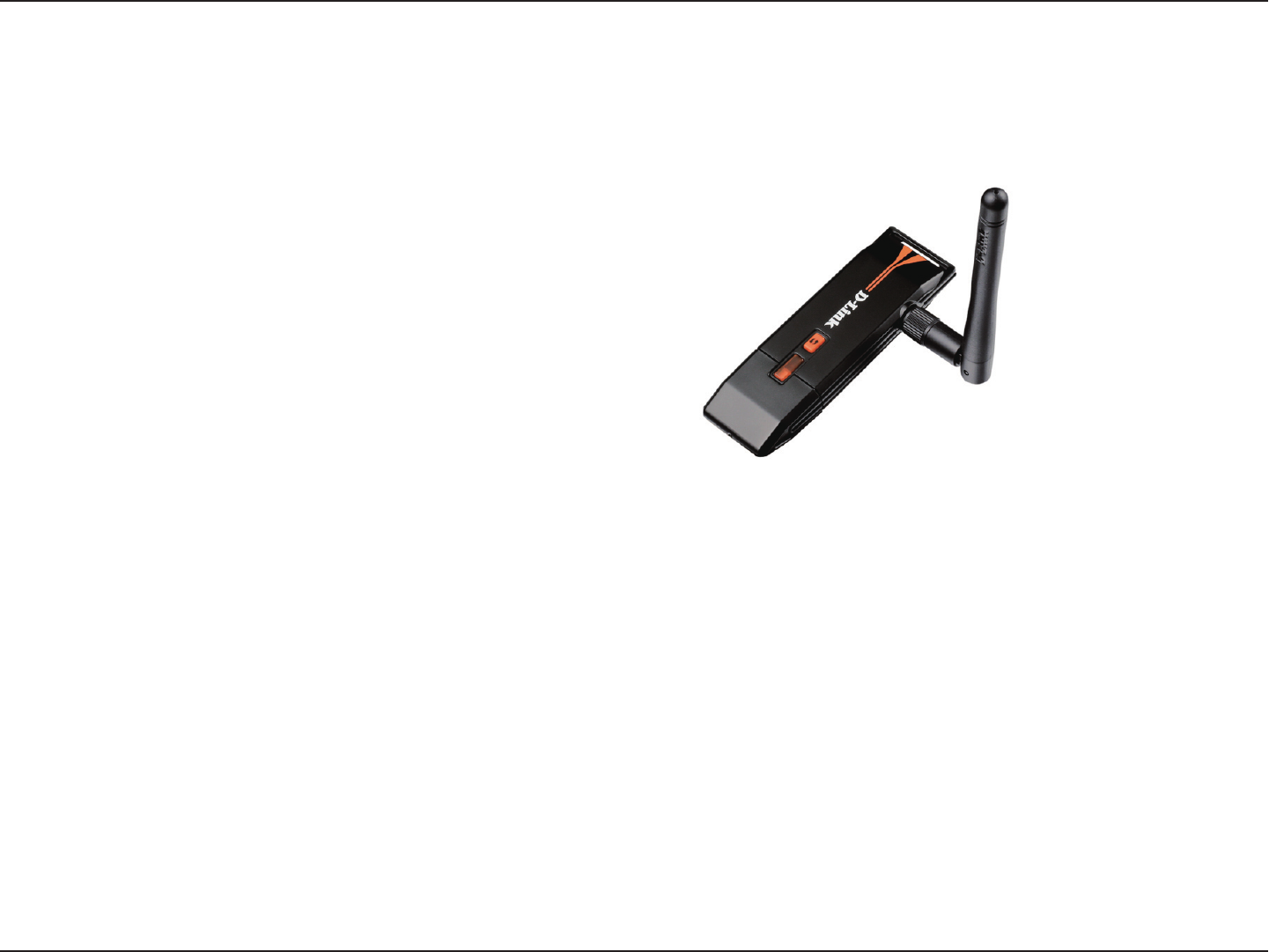
3D-Link DWA-126 User Manual
Section 1 - Product Overview
System Requirements
• A computer or laptop with an available USB 2.0 port
• Windows Vista®, 2000 (Service Pack 4), XP (Service Pack 2), or Windows 7
• CD-ROM Drive
• 300MHz processor and at least 64MB of RAM
• A 802.11n or 802.11g access point or wireless router
Product Overview
Package Contents
• D-Link DWA-126 High-Power Wireless N 150 USB Adapter
• Cradle
• Manual and Warranty on CD
• D-Link Wireless Connection Manager on CD
• Quick Installation Guide

4D-Link DWA-126 User Manual
Section 1 - Product Overview
Introduction
The DWA-126 High-Power Wireless N 150 USB Adapter is a convenient wireless connectivity solution for desktop or
notebook PCs. Instead of stringing Ethernet cables to your PC or dismantling your desktop computer case, the DWA-
126 can enable 802.11n wireless connectivity by simply utilizing your desktop or notebook PC’s USB port.
Powered by Wireless N 150 technology, this High-Power Wireless USB Adapter provides higher transmit data rate and
better coverage than normal 802.11g*. Maximize wireless performance by connecting this USB Adapter to a Wireless
N™ router and stay connected from virtually anywhere in the home. This USB Adapter supports WPA and WPA2
encryption to prevent outside intrusion and protect your personal information from being exposed.
D-Link’s Quick Setup Wizard guides you step-by-step through the installation process. You’ll be able to congure this
USB Adapter without having to call the teenager from down the street to help you. The D-Link Wireless Manager is
included with this product to keep track of all your most frequently accessed networks.
DWA-126 with portable size, powerful reception coverage that is easy for installation and convenient to use. It provides
high performance wireless connectivity to your desktop or notebook PC. Enjoy the many benets of wireless connectivity
today!
* Maximum wireless signal rate derived from IEEE Standard 802.11g and 802.11n specications. Actual data throughput will vary. Network conditions
and environmental factors, including volume of network trafc, building materials and construction, and network overhead, lower actual data throughput
rate. Environmental conditions will adversely affect wireless signal range.

5D-Link DWA-126 User Manual
Section 1 - Product Overview
Features
• Detachable external antenna wireless coverage.
• Convenience of Plug & Play installation.
• Fully 802.11g compatible.
• 802.11n compliant.
• Powered by the USB port; no external power source required.
• USB 2.0 standard*.
• You can securely connect to a wireless network using WPA/WPA2 (Wi-Fi Protected Access) providing you
a much higher level of security for your data and communication than has previously been available.
• Position the DWA-126 almost anywhere in your workspace to achieve the best reception possible.
• Supports Infrastructure networks via an access point
• User-friendly conguration and diagnostic utilities.
* Using a USB 1.1 port will adversely affect throughput.
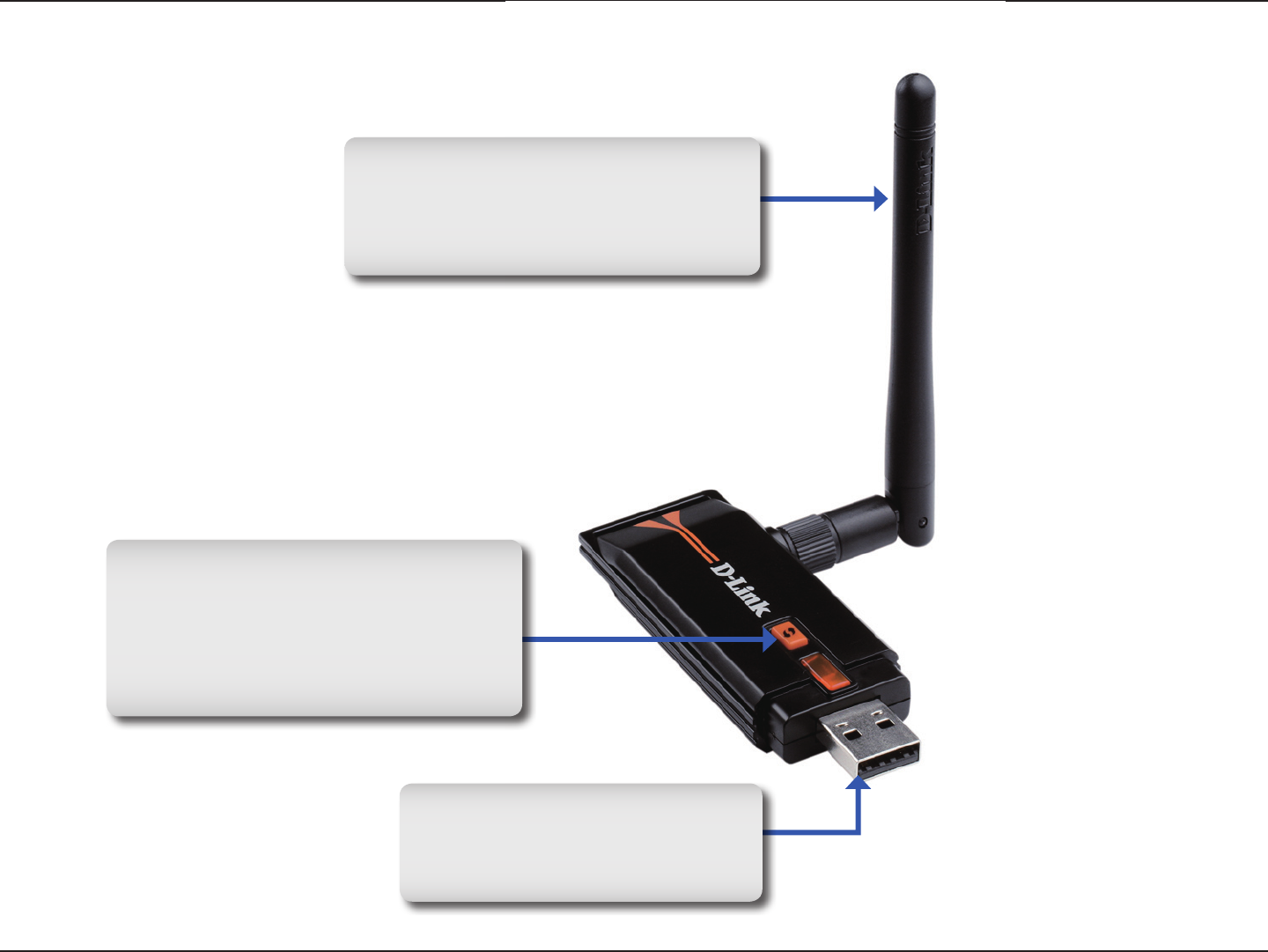
6D-Link DWA-126 User Manual
Section 1 - Product Overview
Hardware Overview
USB Port
Used to connect the DWA-126
to your computer.
WPS Button
Press the WPS button to automatically
connect to a WPS-enabled wireless
router or access point and establish
connectivity. Refer to pg 19.
External Antenna
Detachable and rotatable high power
antenna for 90 degree of vertical and
180 degree of horizontal angle.

7D-Link DWA-126 User Manual
Section 2 - Installation
Getting Started
Installation
This section will walk you through the installation process. If you have a built-in wireless adapter, please disable it in
device manager before installing your D-Link adapter. Also, if you have previously installed another wireless adapter,
please make sure any software is uninstalled.
Before installing your new D-Link wireless adapter, please verify the following:
• Remove any previous installations of wireless adapters
• Disable any built-in wireless adapters
• Verify the settings such as the SSID and security settings of the network(s) you want to connect to
Remove Existing Installations
If you’ve installed a different manufacture’s adapter or a different model D-Link adapter, make sure the software is
uninstalled before installing the new software. Some utilities may cause a conict with the new software. If you plan
to use multiple adapters at different times, make sure the utilities are not set to load when your computer boots up.
Windows® XP users may use the built-in wireless utility for all adapters.
To remove any old software:
Windows® XP/Vista™ users: Click Start > Control Panel > Add or Remove Programs.
Windows® 2000 users: Click Start > Settings > Control Panel > Add or Remove Programs.
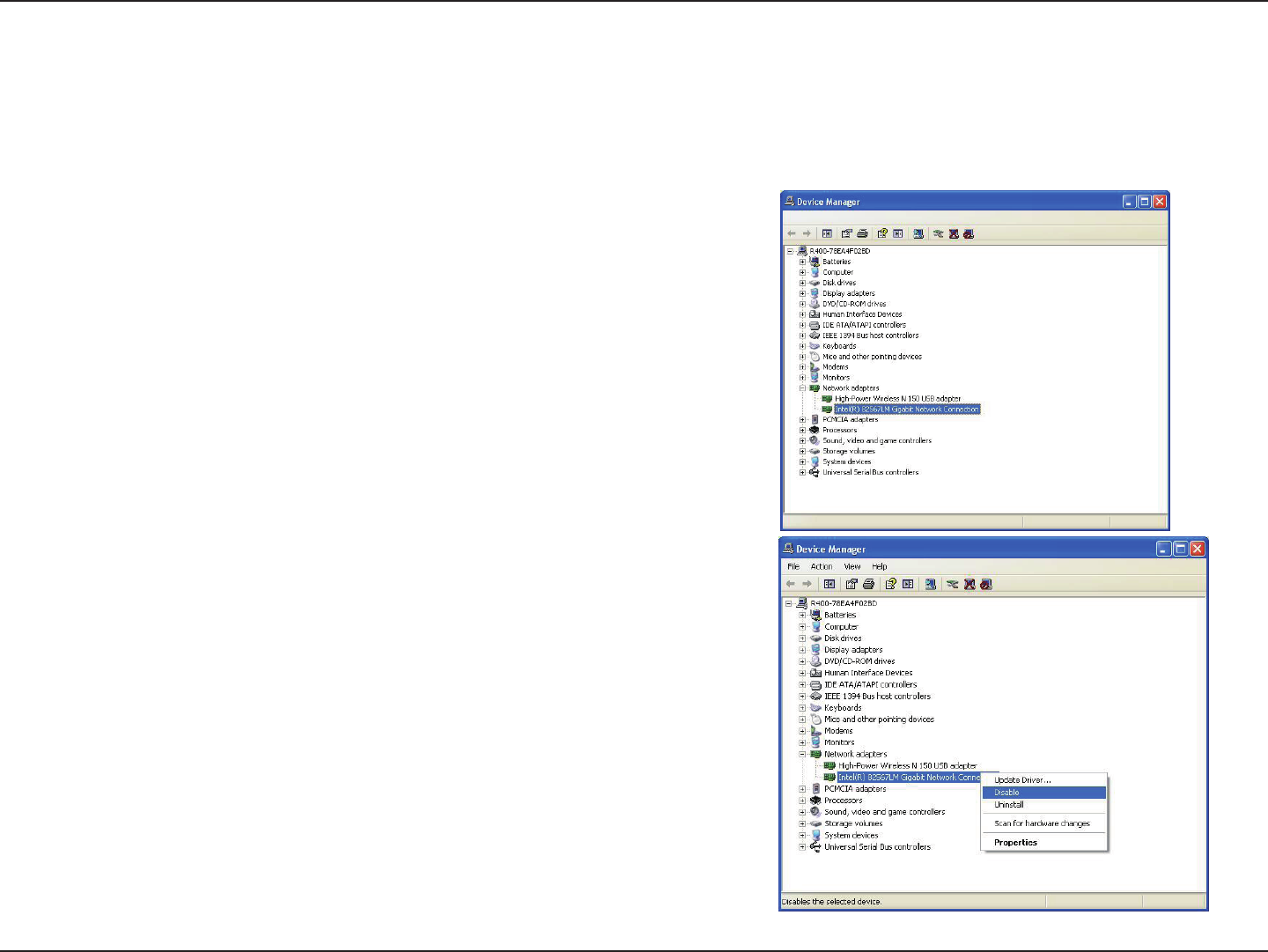
8D-Link DWA-126 User Manual
Section 2 - Installation
Disable Other Wireless Adapters
Most newer laptops may include a built-in wireless adapter. To prevent any conicts with the D-Link wireless adapter,
it is recommended to disable the wireless adapter (as well as any unused Ethernet adapters).
From the desktop, right-click on the My Computer icon and select
Properties.
Click the Hardware tab and then click Device Manager. Scroll down
the list and click the + sign to the left of Network Adapters.
Right-click the adapter you would like to disable and select
Disable.
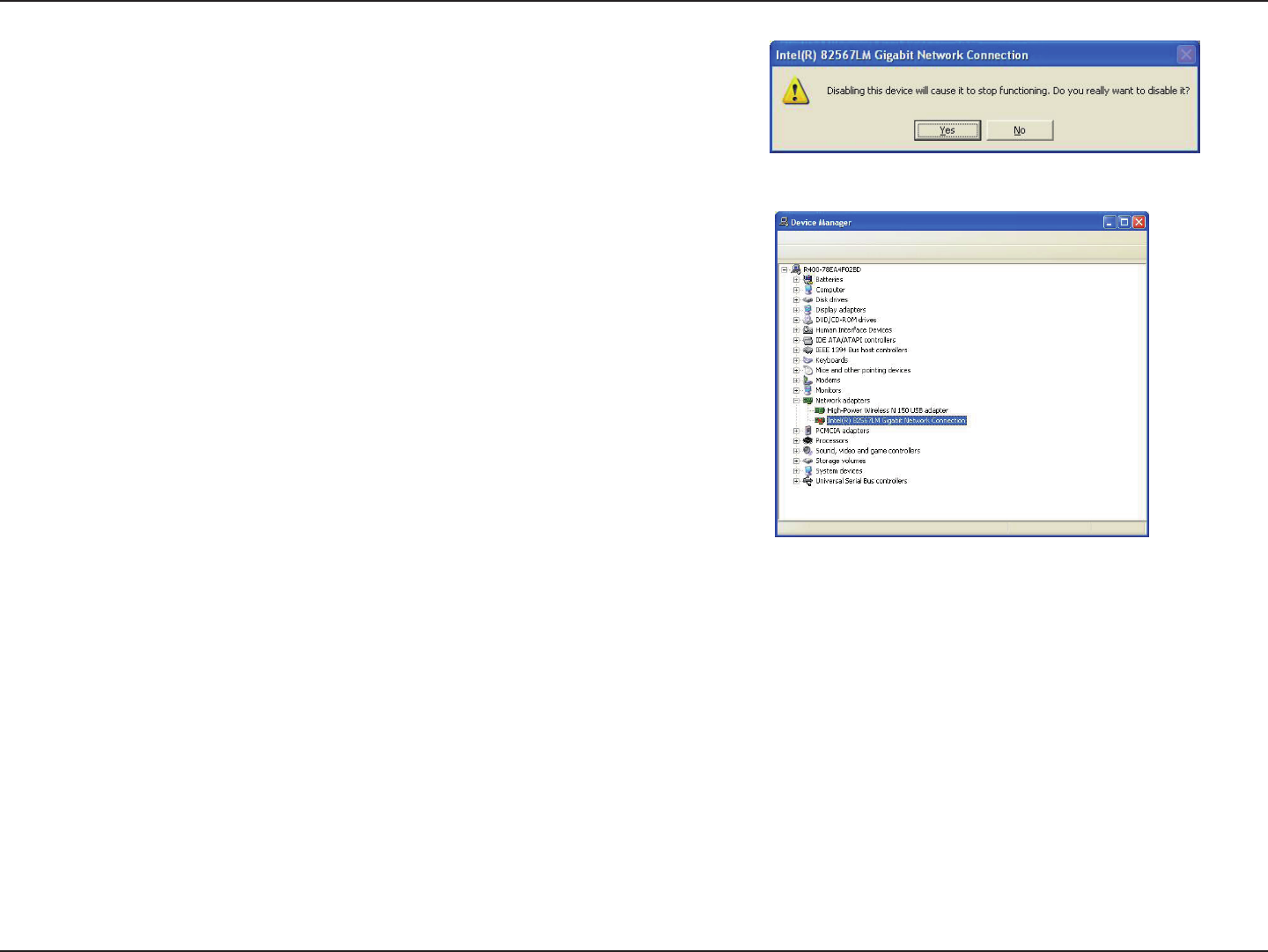
9D-Link DWA-126 User Manual
Section 2 - Installation
Click Yes to disable the adapter.
The adapter is now disabled. When disabled, a red X will be
displayed.
Disabling the adapter will not remove the drivers. If you would like
to use the adapter, simply right-click it and select Enable.

10D-Link DWA-126 User Manual
Section 2 - Installation
Wireless Installation Considerations
The D-Link wireless adapter lets you access your network using a wireless connection from virtually anywhere within
the operating range of your wireless network. Keep in mind, however, that the number, thickness and location of
walls, ceilings, or other objects that the wireless signals must pass through, may limit the range. Typical ranges vary
depending on the types of materials and background RF (radio frequency) noise in your home or business. The key
to maximizing wireless range is to follow these basic guidelines:
1. Keep the number of walls and ceilings between the D-Link adapter and other network devices to a
minimum - each wall or ceiling can reduce your adapter’s range from 3-90 feet (1-30 meters.) Position
your devices so that the number of walls or ceilings is minimized.
2. Be aware of the direct line between network devices. A wall that is 1.5 feet thick (.5 meters), at a
45-degree angle appears to be almost 3 feet (1 meter) thick. At a 2-degree angle it looks over 42 feet
(14 meters) thick! Position devices so that the signal will travel straight through a wall or ceiling (instead
of at an angle) for better reception.
3. Building Materials make a difference. A solid metal door or aluminum studs may have a negative effect on
range. Try to position access points, wireless routers, and computers so that the signal passes through
drywall or open doorways. Materials and objects such as glass, steel, metal, walls with insulation, water
(sh tanks), mirrors, le cabinets, brick, and concrete will degrade your wireless signal.
4. Keep your product away (at least 3-6 feet or 1-2 meters) from electrical devices or appliances that
generate RF noise.
5. If you are using 2.4GHz cordless phones or X-10 (wireless products such as ceiling fans, lights, and
home security systems), your wireless connection may degrade dramatically or drop completely. Make
sure your 2.4GHz phone base is as far away from your wireless devices as possible. The base transmits
a signal even if the phone in not in use.